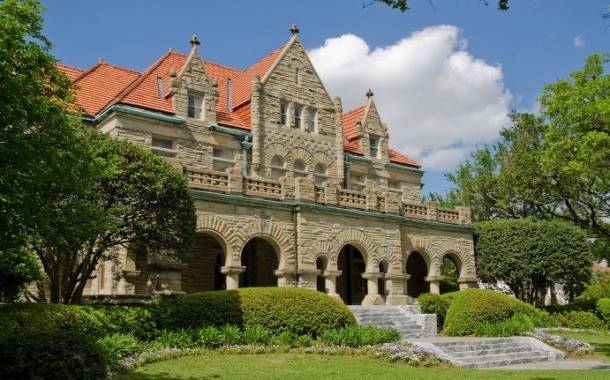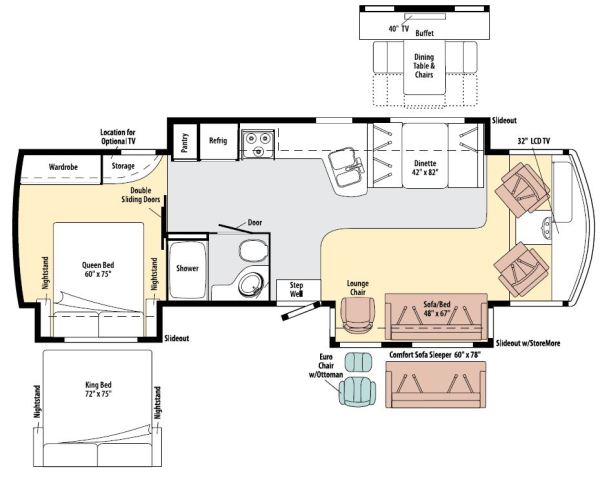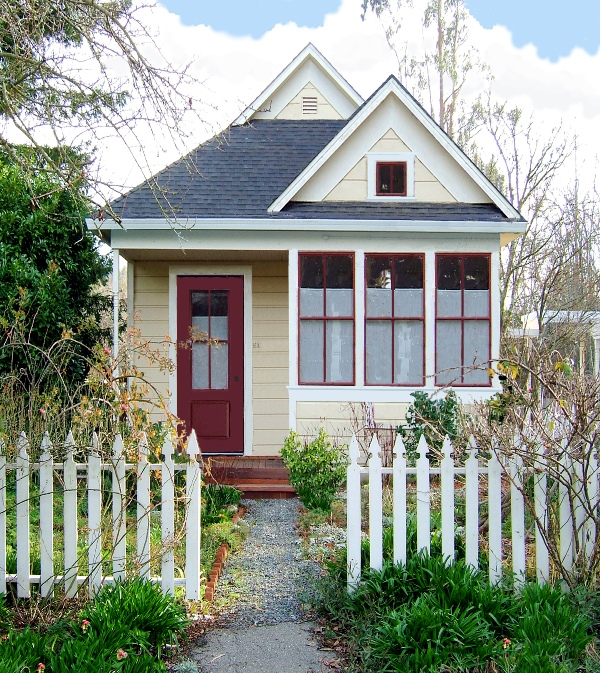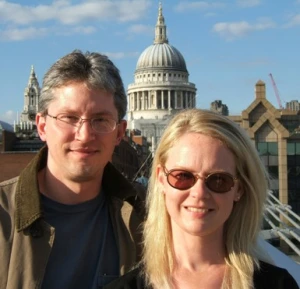
One of the things we always felt pressured by living in the U.S. was the subtle coercion of BIG. Big houses, big cars, big everything. There’s a lot to lament about big. It’s costly, it’s wasteful, it’s demanding. Every square inch of that bigness needs to be maintained and financed. It is, in our view, a horrible waste of time and resources.
Of course our view is a minority one. For the majority, big is desirable, it is status, and even an end unto itself. And because market economies like ours typically give the majority what it wants, we’ve seen a more than doubling of home sizes in the past 60 years. Not only are new homes being built bigger, vintage properties are torn down to make way for giants. In the process the stock of reasonably sized residences has declined, along with the options of the minority who prefer them.
As houses grew, so too did all the stuff that typically fills them. I recall shopping for a washer and dryer and finding only one model that would fit in our now-seemingly palatial 950 sqf apartment. We faced a similar challenge when trying to replace our refrigerator and, more recently, find a vacuum cleaner.
Over the past few decades we’ve marveled at the way our electronics have shrunk in almost magical ways. Often less appreciated is that our appliances have moved in the opposite direction, growing as if on steroids. Meanwhile, our apartment, which we assiduously avoided upsizing, stayed the same size, making the new behemoth appliances practically useless to us. The message was clear: bigger isn’t just better, it is unavoidable. Resistance is futile.
Yet things that can’t continue forever eventually won’t. That day for America’s ever-growing floor plan seems to have arrived in the form of the Great Recession. With the Joneses so obviously upside down on their mortgage and facing the marital and other woes that accompany financial stress, many of the rest of us began to wonder why we ever chased after those awful Joneses in the first place. Clearly they’re idiots.
And so, for a time at least, the average size of new homes built in the U.S. actually declined. But what’s surprising is that we didn’t just build slightly smaller big houses, a niche of truly tiny residences – less than 500 sqf – started to gain favor too.
Micro-homes, as they’re often called, aren’t entirely new. The modern version dates back at least as far as 1997 when Jay Shafer built his 89 sqf abode named Tumbleweed. Over the years he’s produced and promoted a variety of blueprints for homes that take Sarah Susanka’s concept of “The Not So Big House,” which emphasizes quality over quantity, to the extreme. Gone are dining rooms and mud rooms and wasted space of all kinds, replaced with compact efficiency. Resembling nothing more than elaborate playhouses, Jay’s designs have often been used as extensions to larger homes and as vacation cottages.
In recent years, though, they’ve also found a place as primary residences. In fact, tiny houses are now popping up everywhere; from Portland, Oregon and Seattle to Washington D.C. and New York. This past July, New York City Mayor Michael Bloomberg announced plans to commission an entire apartment building where most of the units will measure just 300 square feet.
An obvious driver behind this miniaturization of the modern home is affordability and not just in perennially expensive zip codes like those found in NYC. After four years of grinding recession and tepid recovery, people nationwide are tiring of living with relatives and are seeking other options. Micro-homes, which can often be built for the price of a typical down payment, are increasingly seen as one such option.
Changing demographics are playing an important roll too. Family sizes have been getting smaller for generations. In his July announcement Mayor Bloomberg noted that the city had almost twice as many one and two person households as it does one bedroom and studio apartments. It is hoped that the city’s micro-apartment project will demonstrate a commercially viable way of fixing that imbalance.
Another demographic engine driving toward small is the bubble of boomers who may be looking to downsize in retirement. Add in the continuing economic challenges of high unemployment, stagnated wages and generally modest American savings, and it’s easy to see why some are saying that the time of the tiny house is finally at hand.
As more people downsize their lives an interesting thing happens; they discover the richness of living small. The Berzin family, who built a 168 sqf home in Virginia’s Blue Ridge Mountains, told CNN that “living mortgage-free has given us the freedom to make decisions based on what will make us happy, not what we have to do to pay the mortgage.”
We couldn’t agree more.






















Thanks for the excellent post. What I find amazing is the size of kitchen appliances – especially ranges and refrigerators. We built a new house 4 years ago and it was a challenge because we have never wanted bigger than we actually needed or wanted to maintain. There is a subtle pressure (and sometimes not so subtle) to buy big – even by people who have 6 burner cook tops but never use them. Reality TV shows are a huge influence. We, too, had a hard time finding a washer & dryer small enough to fit into a closet space in a hall.
LikeLike
Bravo! Excellent post. This message needs telling and retelling.
LikeLike
I would love a place like this tiny spot!
Loved the post as well
Says so much doesn’t it about us
Eunice
LikeLike
Love this. When we moved to the United States we couldn’t believe how big everything from chickens to cars to televisions were. And living counter culture is Hard. Takes intentional thought and action. That’s why it’s so important to write about this and encourage others. Thank you.
LikeLike
Living counter culture IS hard. It’s part of the reason so few do it.
LikeLike
My thoughts exactly, but better put.
LikeLike
Would would much rather spend my money on travel…seeing the world…experiences that you cannot duplicate. A large, obnoxious house doesn’t have that capability.
Right on!
LikeLike
I do agree with many of your points here. My husband & I have by choice lived the apartment life for the last 10 years, sprinkled with an occasional housesitting and basement dwelling. We might eventually move into a house, but we never really cared what the Joneses were up to anyway. However, there is another viewpoint that you may be overlooking here. (I cite from my own personal experience) My husband is a philosopher who loves the outdoors, and I an artist and poet. Environment IS essential to our makeup. We obviously haven’t opted for the big house, 2-car lifestyle, but I would be remiss if I didn’t mention floor plan does matter. I’m not saying it has to be big, but it has to “feel” open, giving the mind room to breathe. This is more a creative reason, rather than an economic or status-building one, but a viable perspective nonetheless.
LikeLike
I think we’d be the first to admit that one size does not fit all. We admittedly hold a minority view and we recognize the majority isn’t monolithic. There are many different reasons why people may have opted for houses and things we’d never own. And as long as they’re happy with their choices, who are we to judge.
I don’t quite get the notion, though, that artistic people need some kind of open living space so that their “mind has room to breath.” I’ve never noticed my mind being confined by my surroundings. It’s one of the wonderful things about my thoughts, they’re only limited by my imagination. I’m guessing Thoreau, who lived in a 10 x 15 cottage, would probably agree.
LikeLike
If Thoreau’s small cottage was placed anywhere other than Walden Pond (say, in the middle of the urban jungle), I submit to you that he may not be so inspired. Of course, not all artists or philosophers are the same. Some are perfectly content with confined spaces and white walls. Others (reference ancient Chinese landscapes) need to let their minds move, breathe, and journey even within their own paintings. I am not referring to mansions here or oversized houses; I’m referring to the layout of the space. You can have a small square footage separated by many walls and few windows; take that same square footage and “open the floorplan” with fewer walls and more windows, and now there’s potentially a difference in one’s psychology. For an example of this, I cite a friend of mine’s space (again, just personal experience)…an older couple who are long-time empty nesters. Their moderate home had walls right in your face as you walk in the door. It’s just not a hospitable setup from an interior design’s standpoint either. In my opinion, the position of the walls made the congregating feel a bit confining too. Recently, they knocked down a wall and wow, what a difference for them and for their guests. Same square footage; different “feel.”
LikeLike
Excellent article! Couldn’t agree more. The time has come for downsizing, it makes sense on so many levels. My wife and I recently retired and now work only for the extra mad money. We are considering a move from dreary Michigan to Nevada or Arizona. Do we need a 2000 sq foot home out there? Nope. Be well!
LikeLike
Good luck in your search.
LikeLike
This is a topic close to our heart. We have over the years received a lot of negative feedback from people around us because we have chosen to stay in a smaller house than most. We are a family of 7 in a 3 bedroom home that is just under 1250 sq. feet. We have 2 children in an 8’x12′ room and 3 children in a 9’x9.5′ room., plus the tiniest kitchen and bathroom….but we are happy. I also run my business from home. Staying small has given us many other opportunities and has let us do some wonderful things with our children.
I can’t agree more on the difficulty of finding appliances. Today’s appliances do not fit well into houses built in 1946. We have actually gone to using a bar fridge as that is all that will fit.
(www.islandhomeblog.wordpress.com & http://www.htheblog.wordpress.com)
LikeLike
Along with “the subtle coercion of big” there is also some not so subtle coercion too. It’s like what they say about the nail that stands out – it gets pounded down.
LikeLike
The Not So Big House is one of my favorites. I love looking at the floorplans that have zero wasted space. If we ever built a house, that’s the style we would go with. Having just puchased a new washer/dryer, that looks (and sounds) like it could blast off to the moon any minute, it’s true, the laundry room in a not so big house would have to be built around them.
LikeLike
It’s funny that Britain is full of families who live in houses like the “micro” house in your photo, and there are many more in cramped apartments who dream of one day upgrading to a house that big. Meanwhile in Continental Europe few people would even dream of ever getting out of their little apartment.
It’s striking Americans have a pervasive cultural aversion to smallness. Like in McDonalds, nothing is called “small”. It’s regular, large or extra large. Very bizarre, isn’t it?
LikeLike
My favorite example is Large, Extra Large and Jumbo . . . shrimp. 😮
LikeLike
Thanks for this great post! Moving to the US almost 20 years ago now we reacted quite strongly to the guest for “everything big” here. Our former neighborhood in the north-east is now full of oversized new houses with no space left on the lots. The “palaces” stand almost wall to wall, while previously that neighborhood had moderately sized cozy homes with gardens full of life…sad developments in my view.
LikeLike
It is funny to see these neighborhoods where the houses nearly fill the entire lot – almost like giant town houses.
LikeLike
It’s the same in Australia – everyone seems to want a mansion. We live in a very small house built in 1895 and trying to buy a corner lounge that will fit in our lounge room is impossible. Or a kitchen table that doesn’t seat a dozen people.
LikeLike
The irony is that when we do find modest-sized appliances/furniture they can cost twice as much as the behemoths.
LikeLike
I’ve hated the McMansions from the time they first started popping up. My husband was a pack-rat and no matter what size house we had (always too large for my taste), we managed to fill it up with more junk. Just cleaning a house too large was a great time suck, not to mention the endless searches for something buried somewhere in the clutter. It’s been over two years since I moved to a MUCH smaller space and I’m still getting rid of “stuff”. The biggest problem has been that I hate to just toss it into landfill. It takes so much longer and more effort to find happy homes for much of the junk.
http://www.storyofstuff.org/
LikeLike
Awesome post! I totally agree. I think people can become possessed by their possessions and get big houses just to store all their stuff. I have always loved living in urban areas which means small apartments and couldn’t be happier. I can’t imagine moving the suburbs and think it is completely possible to live (even families in small places).
LikeLike
We’re fans of walkable urban environments too. A car is one of the things I’d like to live without. Unfortunately, so few places in the U.S. are really walkable.
LikeLike
Living like this is a key part of being truly rich! Can’t wait to downsize from our already modest home. More stuff is just more stuff to take care of.
LikeLike
Yup. I often wonder how many people really understand this point: that stuff is really a burden. It’s a burden to pay for, to replace and to care for. Do people factor those costs in when considering purchasing something?
LikeLike
Brian, you are so right. My wife and I were talking on our daily walk about how everything one puts up eventually must come down. So for example, my mom, over many years, has filled her house with ceramic wall sconces. She now has 1000’s of them. I’ve begged her to start the process of downsizing as I can see the day when I will have to come in and clean up. So in a way, STUFF can also be a burden on those you leave behind after you move on. Of course, cash and liquid assets are the way to go if you are thinking about leaving something behind 🙂 That stuff is okay in my book 🙂
LikeLike
Awesome post! I couldn’t agree with you more.
LikeLike
Jack and I are huge fans of the tiny home movement. We had our home featured on the same CNN article you referenced above (http://www.cnn.com/2012/09/21/living/small-homes-irpt/index.html). We try to limit our appliances and get as much function out of one item as possible. Thanks for posting this!
LikeLike
Wow. Small world.
LikeLike
This is an excellent piece.
Small is definitely trending in Johannesburg’s inner city where office buildings are being converted into apartments. But square footage is ludicrously small; single beds barely fitting into the tiny bedrooms. I wanted to lease one of these apartments until I saw that most of the rooms were separated by dry walls. You could hear everything the neighbours were doing. I’m all for a large room with modular furniture that can be moved around for a change of scenery.
LikeLike
We agree with you wholeheartedly. If that time comes when we feel we want to come off the road, whatever we live in will be considered minute, we are sure, compared to the majority of folks. That is ok as most of our family and some of our friends think this lifestyle of ours is quite strange and us along with it (lol).
LikeLike
I am fortunate to live in a small townhouse that is an ideal size for one person, plus it has privacy. So many small residences are built by people out to make a quick buck who don’t think about what it is actually like to live in them. I think often they are built for the rental market, with the idea being that people live in them only for a brief period of their lives, on the way to somewhere “better” ie bigger.
My townhouse has one common wall with a neighbour, which is good and solid. The bedroom and bathroom are located in such a way that they can’t be seen into from the front entrance and I have a small outdoor area of my own. Small things, but they make such a difference to the liveability of a place.
LikeLike
True. Small doesn’t need to mean cheap, although often it is.
LikeLike
I’d be curious to know how big some houses are in Baltimore, Maryland. They look like federal-style homes. So cute.
While I admit we have more room than we need in our home, I don’t think I’d be comfortable in a home that’s 300-square feet.
Thanks for the great visuals.
LikeLike
We have the opposite phenomena here! Increasing building for a very real housing shortage (in part caused by out of control immigration) but with a limit to our available surface area (for obvious reasons) we increasingly live in badly designed rabbit hutches. These Tumbleweed houses are very cute though, wouldn’t mind the lack of space – could have a bigger garden! Just call me Pollyanna!
LikeLike
About time. Bigger is better has long been over-rated, along with more is better. Interesting post
LikeLike
One thing that comes to mind though after watching one of your video links – smaller houses = more houses in less area = more people in the neighbourhood – i.e. # of suburbanites/sq mile goes up … will this come with the usual social issues price tag that many suburbanites are trying to escape?
LikeLike
Hi Lynne,
You don’t specify what “social issues” you’re referring to so I’ll focus my response on the question of price. My gut reaction is that the price of anything is determined by the demand for that thing tempered by the cost of supplying it. Obviously, the physical cost of building smaller units is going to be lower than building larger ones (less wood, less labor, etc.) But the real cost driver of housing in pricey environments is scarcity, not construction costs. Prices are high because demand is great and supply is limited by physical and regulatory constraints. If you increased the number of units available for sale by making each unit smaller, the scarcity premium would decline. So too would the actual cost of construction. So all else being equal, smaller units really should reduce home prices.
LikeLike
Well said. We need to re-evaluate our priorities including regaining natural space. We’ll need to reclaim land in order to feed the masses. In my part of the world, city sprawl is swallowing up prime farm land. Where do people think their food will come from?
LikeLike
We never want to own a house again…cause it is such a waste of space! But if we did have to look at living in a place once the kids have grown up then we would love a little unit. One overlooking the water front, and where there is only enough room for a couple – a bed is all we need!
Love the idea of downsizing into smaller spaces.
LikeLike
BIG, or on the street. I love the cottage, more people should try a simple life maybe..
LikeLike
we saw these very small houses in Barbados called “chattel houses”, interesting how people can live in 2 rooms.
http://adventureincroatia.wordpress.com/2013/01/19/travel-diaries-chattel-houses-in-barbados/
LikeLike